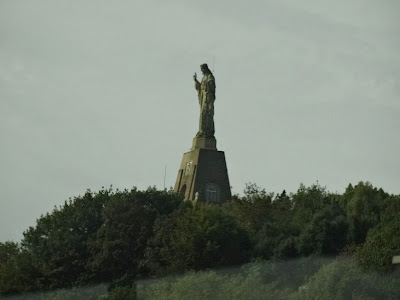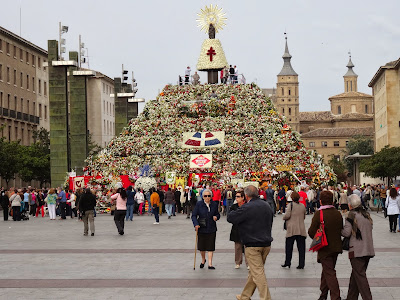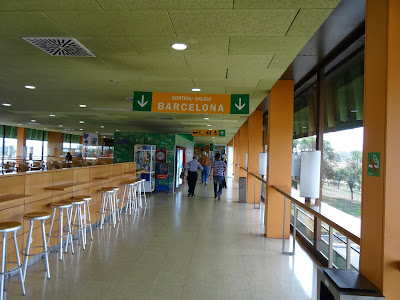Monday, October 14, 2013
Today we departed Santander for Bilbao, San Sebastian and Pamplona, where we spent the night.
Bilbao

The famous Guggenheim Museum in Bilbao, Spain houses an extensive collection of modern art. Unfortunately, as museums are closed every Monday in Spain, we were only able to admire the exterior of the interesting structure.

A 40 foot sculpture of stainless steel, soil and flowering plants, known as Puppy, adorns the front plaza of the Guggenheim Museum. Seen here encased in scaffolding for a periodic refreshing of the potted plants.

Street scene in downtown Bilbao with the Guggenheim Museum at the far end. Carol and I had just finished having coffee at the outside café on the left.
Getaria

On the way to San Sebastian, we passed the Statue of Juan Sebastian Elcano at his birthplace of Getaria, Spain. He was the Spanish explorer who took command of the Magellan's expedition and completed the first circumnavigation of the world after Magellan died in the Philippines before completing the voyage.
San Sebastian

Catedral del Buen Pastor (Good Shepherd Cathedral) of San Sebastian, Spain

Produce market in downtown San Sebastian.

Christ of the Sacred Heart overlooks the city of San Sebastian.
Most cities and towns in Spain have a statue of Christ or the Virgin Mary situated on a hill overlooking the city with a hand raised as if giving a blessing to the inhabitants below.

An local shop with a distinctive product closed for the daily siesta (we assume).
Upon closer investigation, there is a sign in the window that says "open". Could it be that the proprietor is a little too familiar with his/her merchandise?
The daily siesta for shops and businesses is from approximately 2:00 pm until 5:00 pm.

It's not Hawaii, but being a summer resort on the seacoast, San Sebastian does have a surf shop...

...and surfers !!

Another picturesque view of mountains and valleys in Northern Spain on the road from San Sebastian to Pamplona.
Pamplona

Plaza del Castillo (Castle Square) in Pamplona, Spain with Hotel La Perla on the far side.

Plaza del Castillo is a 150,000-square-foot mall, known as the city's "living room," is surrounded by hotels with decorative balconies, outdoor cafes with colorful awnings, and souvenir shops stocked with everything from postcards to figurines of Catholic saints.

Hotel La Perla is the most famous hotel in Pamplona, Spain.
Hotel La Perlais located in the Plaza del Castillo
(Castle Square), with one side facing Estafeta Street, one of the main routes in the Running of the Bulls. The balconies of the hotel are among the most coveted sites from which to view the event. Opened on June 5 of 1881, it is the city's oldest hotel, and the oldest still in operation in the country. The hotel was popularized by having many notable guests, including Orson Welles, Charles Chaplin, and in particular, Ernest Hemingway. Hemingway referred to Hotel La Perla in his novel The Sun Also Rises. While Hotel Quintana is the mainstay of The Sun Also Rises, its colleague, in the north-east corner of the Plaza del Castillo, was the author's favorite. He stayed here on most of his visits, becoming so much a part of its fabric that the room he always booked has been preserved in his name.

A clothing shop named El Panuelico de Hemingway translates to "Hemingway's Neckerchief ".
The tradition during fiesta is to wear a white shirt, trousers or skirt with the red sash and the Pañuelico de Fiestas (Fiesta Neckerchief). Everyone wears the so-called "fiesta uniform”, thus creating beautiful combinations of red and white.

Sign showing the route of the Running of the Bulls.
The Running of the Bulls (
encierro) is a practice that involves running in front of a small group of bulls that have been let loose on a course of a sectioned-off subset of a town's streets. It is the most important event during the fiestas of San Fermin – it has become the symbol of Pamplona and the reason why this city is known worldwide. The origin of this event comes from the need to transport the bulls from the off-site corrals where they had spent the night, to the bullring in preparation for the afternoon bullfight. Revelers would jump among them to show off their bravado. In Pamplona and other places, the six bulls in the event are still those that will feature in the afternoon bullfight of the same day

Our guide explaining the Running of the Bulls, the highest profile event of the San Fermin festival, held every year from July 6–14.
Among the rules to take part in the event are that participants must be at least 18 years old, run in the same direction as the bulls, not incite the bulls, and not be under the influence of alcohol (uh-huh). Every year, between 200 and 300 people are injured during the run. Although most injuries are not serious, 15 people have died since recordkeeping began around 1910.

One of the narrow streets used for The Running of the Bulls in Pamplona, Spain.
In order to direct the bulls through the narrow streets, a double wooden fence is erected in those streets where there is enough space for it, while in other places the buildings of the street act as barriers. In addition to directing the path of the bulls, the fence provides enough space for runners to exit while keeping the bulls corralled in case of emergency.

This status of Ernest Hemingway was sits outside the Pamplona bullring. The English translation of the dedication reads "To Ernest Hemingway, Nobel Laureate in Literature, friend of this city and admirer of its fiestas, which he discovered and brought fame to."
Hemingway journeyed to Pamplona on nine occasions, the most prolific burst between 1923 and 1927, when he visited every year. Each time he came for San Fermín, the city's famed fiesta of bullfighting and brutality, drink and song. Before Hemingway, Pamplona was not famous. Much of its current-day mystique stems from
The Sun Also Rises, the masterpiece that the writer distilled from the ripe fruits of his Spanish summer of 1925. Indeed, you might even say that he forged the modern idea of Pamplona and San Fermín, his celebratory words transforming what had been a provincial party into a global event.
Entrance of the bullring at Pamplona, Spain, the third largest bullring in the world, after Mexico City and Madrid. The square metal plates, shown here lining either side of the entrance corridor, are where the wooden fence that guides the bulls along the route of the encierro and into the bullring is installed.
On each of the eight days of the San Fermín festival, a first rocket is set off at 8 a.m. to alert the runners that the corral gate is open. A second rocket signals that all six bulls have been released. The third and fourth rockets are signals that all of the heard has entered the bullring, marking the end of the event. The average duration between the first rocket and the end of the
encierro is four minutes.
The herd is composed of the six bulls to be fought in the afternoon, six steers that run with the bulls, and three more steers that leave the corral two minutes later. The function of the steers is to guide the herd. The average speed of the herd is 15 mph. The length of the run is 903 yards. It goes through four streets of the old part of the city before entering into the bullring through the corridor seen above.

























































